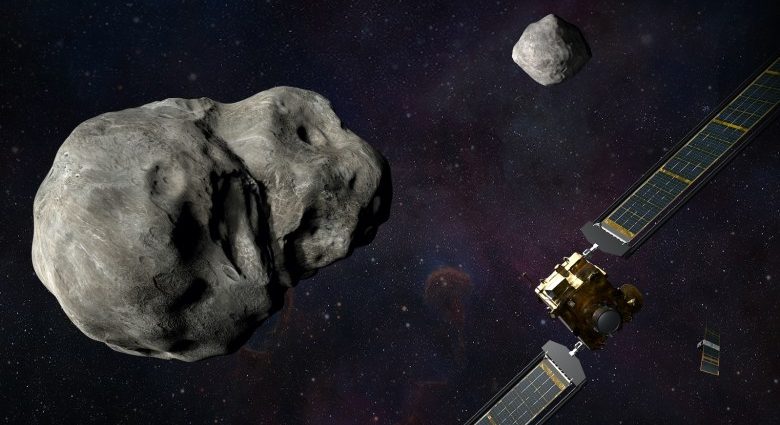In what seems like a scene from a science-fiction thriller, NASA has successfully used a spacecraft to deflect an asteroid off-course in the first-ever mission of its type.
In a September 27 press release, NASA announced that day before its Double Asteroid Redirection Test (DART) successfully impacted the asteroid Dimorphos after ten months of flying in space from 11 million kilometers away.
The impact is expected to shorten the asteroid’s orbit by 1%, or roughly 10 minutes. Dimorphos is a small body 160 meters in diameter orbiting Didymos, an asteroid 780 meters in diameter. Neither asteroid poses a threat to Earth.
DART was guided to its target by its only instrument, the Didymos Reconnaissance and Asteroid Camera for Optical navigation (DRACO), alongside sophisticated guidance, navigation and control systems that worked with Small-Body Maneuvering Autonomous Real-Time Navigation (SMART Nav) algorithms to target Dimorphos.
These systems guided the 570-kilogram box-shaped DART for 90,000 kilometers of space, impacting Dimorphos at 22,530 kilometers per hour, slightly slowing the asteroid’s orbital speed.
The impact was assessed by DART’s companion, the Light Italian CubeSat for Imaging of Asteroids (LICIACube), from the Italian Space Agency. LICIACube captured images of DART’s impact with Dimorphos and the resulting cloud of ejected matter, allowing researchers to assess better the result of the kinetic impact deflecting the target.
Over the coming weeks, a global team will use dozens of telescopes worldwide to confirm that DART’s impact altered Dimorphos’ orbit. However, as LICIACube does not have a large antenna, images will be downlinked to Earth one by one in the coming weeks.

DART’s success provides essential capabilities to defend Earth from a devastating asteroid impact, proving that humanity is no longer powerless to prevent this kind of disaster, notes Lindley Johnson, NASA’s planetary defense officer.
DART could one day be used to change the course of an asteroid and preserve life on Earth as we know it, notes Ralph Semmel, director of the Johns Hopkins Applied Physics Laboratory.
A 2018 report by the UN Office for Outer Space Affairs notes that impacts from asteroids and comets can potentially damage life or property on Earth and have contributed to mass extinctions in the past.
Dimorphos and Didymos are examples of Near-Earth Objects (NEOs), asteroids or comets at least within 50 million kilometers of the Earth’s orbit. The UN report notes that of 18,000 known NEOs, 2,000 are classified as Potentially Hazardous Objects (PHOs).
PHOs are much closer at 7.5 million kilometers from the Earth’s orbit and measure more than 140 meters across. The report mentions that an object of that size can cause devastation on a regional scale with global consequences.
The report notes the devastating effects of such an impact, citing the 2013 Chelyabinsk meteor, wherein a house-sized meteor blew up 22 kilometers above the city, releasing energy equivalent to 440,000 tons of TNT, smashing windows in a 517 square kilometer area and injuring over 1,600.
The event was a wake-up call to what more needs to be done to detect larger asteroids before they strike Earth, notes Johnson.
Given the Chelyabinsk meteor impact, the report states that NEOs smaller than 140 meters can cause severe damage without global consequences. It further says that even a 10-meter NEO can damage buildings and inflict injuries.
Given the threat posed by NEOs, in 2019, NASA published its Planetary Defense Strategy wherein it aims to detect NEOs, determine their orbits, characterize their properties using all-source data per Congressional guidelines; develop new technologies for NEO detection and impact mitigation, and enable research in small planetary bodies to study how the solar system formed and determine hazards to life on Earth.
Not to be outdone, this April, the China National Space Administration (CNSA) announced that it will conduct its first asteroid deflection test in 2025 or 2026.

In a CCTV exclusive interview, CNSA deputy director Wu Yanhua said that China would begin to establish a NEO defense system jointly to address the threat of their impacts and contribute to China’s strength in protecting Earth and human security.
Wu emphasized establishing ground and space-based early warning systems, identifying which NEOs pose a threat to Earth and studying and exploring the relevant technologies for planetary defense.
In addition, China’s 2021 White Paper on its space program mentions that China will actively participate in discussions on international issues and the development of relevant mechanisms, including NEO monitoring, response and planetary protection.
It notes that China has made progress in NEO detection and tracking and aims to study plans for a NEO defense system that increases its capacity for NEO monitoring, cataloging, early warning and response.
Great powers often provide public goods in the international system, including in regard to human security, and win recognition and deference from lesser powers in acknowledgment of their leadership status.
Planetary defense thus may soon become a new area of competition between the two superpowers, as both bid to outdo each other in providing an emerging public good while showcasing respective political systems and ideologies and flaunting their scientific prowess to win respect in the international community.

